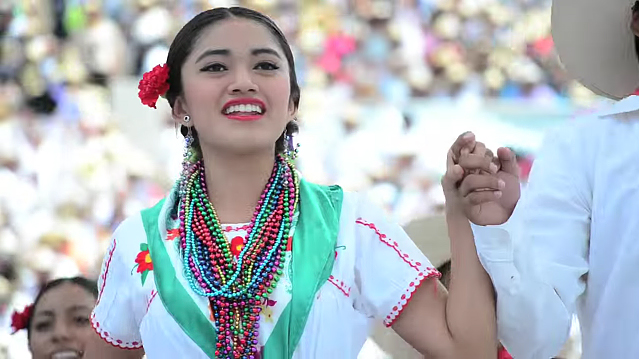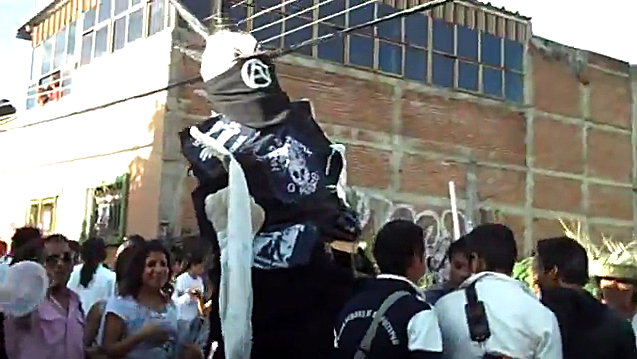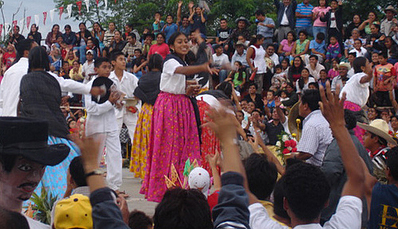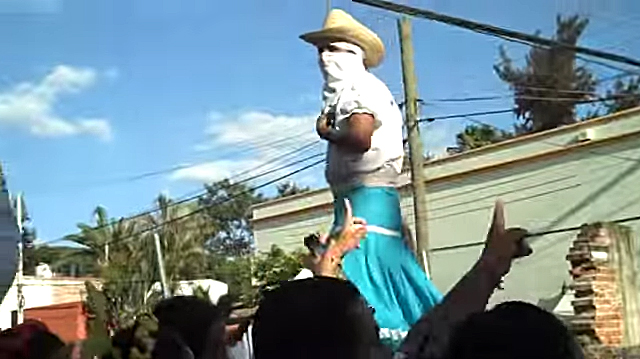Guelaguetza festivals, held in late July every year in Oaxaca City and other nearby towns of southern Mexico, celebrate the acts of giving and receiving in traditional Zapotec culture. The participants are famous for their extremely colorful costumes and dances. Unfortunately, according to a recent report from Public Radio International, the festivals have become highly commercialized. As an alternative, the Zapotec are banding together to form People’s Guelaguetza festivals. The people’s festivals are thronged with the Zapotec themselves rather than with tourists.

A news story in 2005 explained that there are several quite different types of giving and receiving in traditional Zapotec society. The Zapotec love to freely give to one another, often food or other types of gifts, without expecting that the gifting will be returned. They realize, of course, that the giving will usually be reciprocated, but that the return generosity will not be calculated or expected.
But their gifting is more complicated than that. They also celebrate the Guelaguetza: formal, ritualized exchanges, where people give their time and their products to others. But they keep quite careful track of their gifts, with a full expectation that they will be reciprocated at some point. The gifts at Guelaguetza, given primarily to family members, could best be described as loans that are free of interest.
The thrust of the PRI story was that the annual Guelaguetza festival is being superseded, at least among the Zapotec themselves, by their Guelaguetza Popular, their “People’s Guelaguetza,” which is becoming increasingly popular in Oaxaca City. The problem is that the carefully managed, internationally popular festival has become a major economic support for the local economy. Ticket prices start at roughly US$50.00. In addition to the costs, which are beyond the budgets of many locals, the lines and waits to get into events are lengthy.

The People’s Gueleguetza is organized by a dissident teachers’ union. Admission to events is free, and though superficially the street parades may look similar to the state-run events, there are significant differences. The parades, called “calendas,” include brass bands, giant puppets, and costumed dancers. Some people simply line the streets, while throngs of Zapotec parade through downtown districts with thousands of individuals participating as the parade moves along. The essence of the festivities is for the people to mingle with the dancers and musicians, unlike the separation imposed at the state-sponsored events.
Another major difference is that the popular events often include people carrying banners bearing slogans such as “no forgiveness, nor forgetting.” Marchers chant slogans demanding that political prisoners be released. The marchers demand such other popular progressive reforms as an end to budget cutting for education and similar public services.

The PRI reporter, Shannon Young, questioned Salvador Aquino, a teacher from Miahuatlan and a dancer in a delegation from the town. Mr. Aquino told her, “I think it’s necessary to rescue the real meaning behind the Guelaguetza. The Guelaguetza isn’t about the commercialization and selling of the indigenous person as a registered trademark,” he said. His further comment captured the essence of Guelaguetza: ““I’m sharing what I do, my dance moves, my music. That’s what the real Guelaguetza is all about: coming together as brothers and sharing.”
The reporter spoke with Yaneri Castro and two of her assistants who were along the parade route giving away tacos filled with rice and hard-boiled eggs to participants. They represented an environmental club attended by elementary school children in the nearby city of Villa de Zaachila.

Ms. Castro told Ms. Young that donations from Zapotec migrants in the U.S. had provided the funds to support the Guelaguetza Popular in this way. They planned to give away 500 tacos to participants. She said that giving away food was an important way to support the People’s Guelaguetza. “So that they don’t give up the fight,” she said.
The “fight” she was referring to has been the struggle with the government of Mexico over what it terms “structural reforms,” particularly reforms across the country that are supposed to make teachers more accountable. These “reforms” have been opposed by indigenous teachers, such as the Zapotec in Oaxaca, for several years.